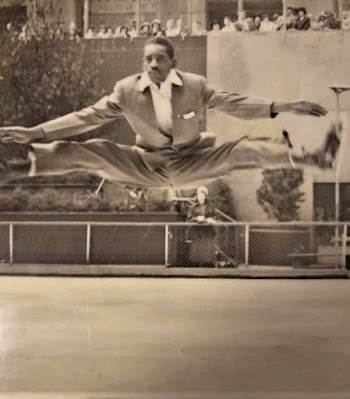When you dig through skating history, you never know what you will unearth. In the spirit of cataloguing fascinating tales from skating history, #Unearthed is a once a month 'special occasion' on Skate Guard where fascinating writings by others that are of interest to skating history buffs are excavated, dusted off and shared for your reading pleasure. From forgotten fiction to long lost interviews to tales that have never been shared publicly, each #Unearthed is a fascinating journey through time. This month's 'buried treasure' is an article called "Origin Of The Ten-Step", which first appeared in "Ice Skating" magazine in June of 1947. It was penned by skating instructor Elsbeth Muller, who with her brother George invented several ice dances, including the Dutch Waltz, Fiesta Tango and Willow Waltz.
"ORIGIN OF THE TEN-STEP" (ELSBETH MULLER)
In an article on the "Evolution of Ice Dancing" by E. van der Weyden in the "Skating World" of January, 1945, it was mentioned that the author had been unable to find out who was the originator of the ten-step.
When reading this I immediately felt inspired to clear up by the mystery and write my story of the ten-step.
It was on one afternoon during the first winter of the Eispalast in Berlin, 1908-09, when my brother George watched Herr Hirsch, from Vienna, showing new dances to Ludovika Eilers, (now Mrs. Walter [Jakobsson] of Finland).
He remembered the steps so well that he was able to teach me my part, and we danced the ten-step the same evening with a large crowd around. The name was the dance was 'Schöller-Schritt', we are told.
In the same year, another visitor from Vienna, Herr Schwarz, showed me the additional four-step with a short outside roll on the fourth step. The long roll of four beats developed much later in New York.
From the Eispalast in Berlin the Schöller dance, mostly done to waltz time, spread all over the world under the more convenient name of the ten-step or fourteen-step.
In "Kunstfertigkeit im Eislaufen" by Rob Holletschek, I have on my desk the 6th edition of 1904. Franz Schöller is credited with four dances marked 1889, one of them is the original ten-step with man's and lady's steps diagrammed.
The only difference from the ten-step we know is that a three-turn was used by the man on step 3, followed by ROB.
The lady's steps 8 and 9 are marked LOF-ROB. On step 1 the left foot was crossed over the right on LIB.
I agree with E. van der Weyden that the habit of doing 8 and 9 on inside edges by many lady skaters was due entirely to lack of ability to execute an outside mohawk.
George and I always taught outside mohawks, although many years back, while discussing these steps, I was told that I was all wrong - that in Austria they were done on inside edges.
We also preferred bringing our feet close together at transitions instead of the original way of XF and XB chassé, or taking wide steps, with the result that we were complimented frequently on the smoothness of our dancing.
I possess a list of nine compulsory dances (Pflichttanze) from Vienna. The first one is named the 'Schoellerschritt' or 'Zehnschrittwalzer' (ten-step waltz), No. 5 is the 'Mejstrikschritt' with a rocker for the man on 4, 5, 6. All other steps are the same as in the ten-step. No. 6 is another variation, the 'Mondwalzer' (Bohatsch). The man, on step 7, goes into LIF-RIB spread-eagle changing to ROB on 8, the lady does a XF-ROF on step 7.
Unfortunately, no timing is given. I remember, however, that steps 1, 2, 4, 5, 8 and 9 were short and 3, 6, 7 and 10 held longer. Mostly, men wrongly shortened 7 and 8, which did not help team-work, until short steps of equal length, with the exception of 3 and 10, became standardized.
In my article in "Skating" (January, 1932) I mentioned that I prefer at the end of step 9 to slide the left foot down, not crossed over but alongside the right foot, lifting it in front, thus matching my partner's free leg on step 10.
When standardization of ice dancing was going to be discussed in New York in 1936, I pointed out the neatness of the open position on 8 and 9, with the free foot trailing on step 10, to Maribel Vinson, who was the chairman of the USFSA Dance Committee and had asked me for help and advice.
Standardization was very successful. Ever since, the fourteen-step to march music has become one of the most popular dances on ice and rollers.
Skate Guard is a blog dedicated to preserving the rich, colourful and fascinating history of figure skating. Over ten years, the blog has featured over a thousand free articles covering all aspects of the sport's history, as well as four compelling in-depth features. To read the latest articles, follow the blog on Facebook, Twitter, Pinterest and YouTube. If you enjoy Skate Guard, please show your support for this archive by ordering a copy of the figure skating reference books "The Almanac of Canadian Figure Skating", "Technical Merit: A History of Figure Skating Jumps" and "A Bibliography of Figure Skating": https://skateguard1.blogspot.com/p/buy-book.html.



















































